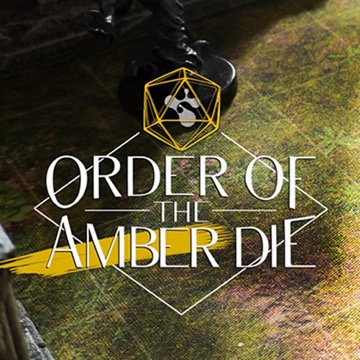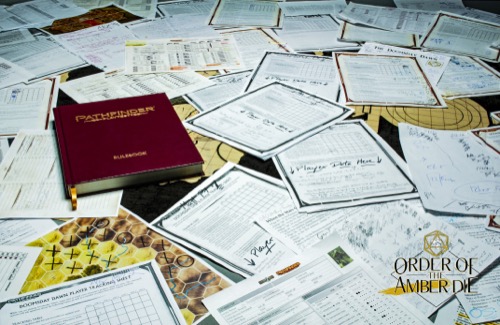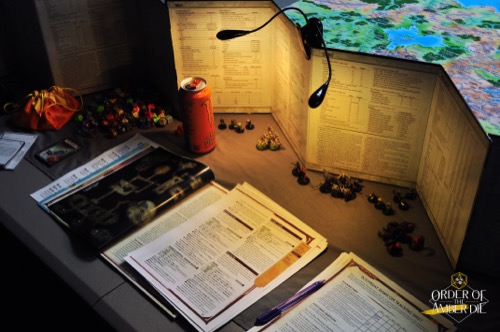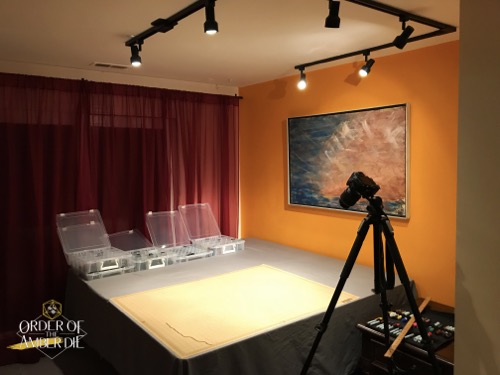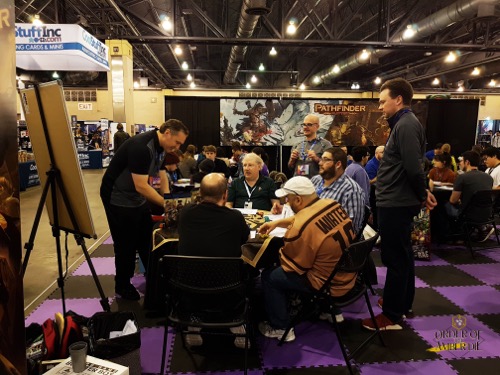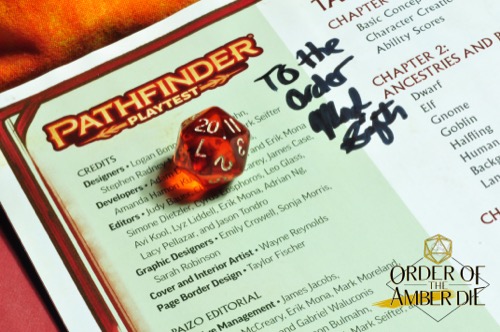Before letting the folks from the Order of the Amber Die get their final thoughts regarding the Playtest out there, I want to thank them for the heroic effort they made in getting this material to all of us. It was great not only hearing about the play experience and seeing the thorough data, but it was also amazing to gaze at the gorgeous pictures. So, thanks to the Order of the Amber Die! Take it away, y'all!
In the Order, as with many role-playing groups, we hold several planning sessions before beginning any major campaign or project. Of equal importance to us, however, is having at least one session of reflection following each such endeavor. These are fairly casual, with each of us taking turns going around the table discussing our favorite aspects of an Adventure Path, in-game or out-of-game problems we encountered, or even answering the usual list of discussion questions our GM has written on a dry erase board. We also like to go through the photos that didn't appear on the Paizo Blog or our social media, laughing at some of the more candid moments from a project. By the end of a good session of reflection, we've always got a list of improvements we want to make for next time. We're excited to be able to share some of those reflections here, including several fun photos of various aspects of our playtest experience.
Before reading these reflections, it might be helpful to catch up on both our experiences and data from our previous playtest blogs:
Part 2: "In Pale Mountain's Shadow"
Part 3: "Affair at Sombrefell Hall"
Part 5: "The Heroes of Undarin"
Part 7: "When the Stars Go Dark"
Cumulative Playtest Data
- Total number of published adventures completed with Doomsday Dawn: 148
- Total time spent creating characters for all players in DoomsdayDawn: c. 64 hours
- Total time spent playing Doomsday Dawn: 76 hrs, 13min
- Total recorded time spent in GM preparation for Doomsday Dawn: 55 hrs, 51min
- Number of words written by GM for playtest surveys/reports/feedback: c. 17,000
- Total time spent during setup/breakdown of playtest scenarios: c. 21 hours
- Accumulated travel time by playtest participants: c. 60 hours
- Overall win/loss record throughout Doomsday Dawn: 4-3
- Total number of times a character reached 0 Resonance in Doomsday Dawn: 12
- Average number of times a character reached 0 Resonance during a scenario: 1.7
- Average number of Hero Points given to party per scenario: 38
- Average number of Hero Points used by party per scenario: 23
- Average number of Hero Points used by each character per scenario: 6
- Total number of character deaths in Doomsday Dawn: 13
- Average number of character deaths per scenario: 1.8
Favorite Aspects of the Playtest
Adam: Resonance
Matt: Critical successes/failures for spells
Dan: Balance among character classes
Erick: Hero points
Sean: Three-action economy
GM Reactions
Here I'll provide two common points addressed in my GM open surveys.
Very early on in the playtest, resonance seemed to establish itself as one of the most significant new changes to the game. As a GM who witnessed a dozen or more full campaigns during the 3.5/3.75 era, I saw plenty of examples of the use and possible abuse of magic items and was excited from about the prospect of a solution in the new edition. With the introduction of resonance, gone are the days of buff stacks, quivers stuffed with wands of cure light wounds, or saddlebags full of my favorite culprit from version 3.5: wand of lesser vigor. Along with our custom initiative board, OAD even had our "Buff Tracker 2011," which will soon be gathering dust with some of our other defunct materials from previous editions. We know full well what it did to our campaigns to employ an overabundance of such magic, and while we still had a good time in those years, I'm eager to see how the game plays with the addition of resonance. While we still haven't seen the final version of resonance, I appreciated both the effort Paizo made to provide balance with magic usage, and the courage it took to do so.
After seven scenarios of observation, the Pathfinder Playtest clearly established itself at our table as a game with a high amount of mobility compared to the previous edition. The absence of universal attacks of opportunity, coupled with the three-action economy, created a feel of fluidity in the great majority of our combats. Just as it felt like no monster or character could be cornered easily, it also seemed as if no one was truly safe in the back ranks of the marching order anymore. Even the very concept of marching order felt like a loose term, since once each character received their first three actions in a combat, everything was up in the air. The game may have seemed a bit fast at first—perhaps even scary—especially for the players whose combat routines had been established for years. As the scenarios rolled on, however, I watched them adapt and develop new tactics, eventually finding a comfortable existence within the broader confines of the playtest's combat. This being said, there were actually quite a few points throughout the playtest where battles broke the limits of the standard 24" x 30" Flip-Mat. As such, I ran some of the applicable encounters on different sizes of maps (36" x 36", 27" x 39", 30" x 40", and 40" x 60"). In the end, the larger maps all felt more comfortable and better able to accommodate the play found in the playtest, with 36" x 36" feeling near perfect, and 40" x 60" being enjoyable but far more luxury space than necessary.
Player Captain Reactions
I'll try my best to summarize what all of the players have wanted to see addressed, as well as some of my own reflections. (Matt, Player Captain)
One change that proved interesting was the new critical success/failure system. Of course, the rules for critical hits with weapons are different now, but the bigger change seemed to be critical successes and failures for spells. Prior, the wildest fluctuations in damage during a round seemed to occur from massive critical hits from x3 or x4 weapons (often power attacking to boot). Now, the greatest variability seems to come from area-of-effect spells where multiple enemies are forced to make saving throws. The variety of effects from a critical success (usually no effect) to a critical failure (usually double effect) is significant, and it made spells more interesting and unpredictable throughout the playtest.
All of the players enjoyed the inclusion of hero points in the new system, and we were fortunate to see the entire range of options for their use. Most common, was to see one of our players toss two tokens into the center of the table and go for a re-roll when it mattered (often a saving throw or special attack). The act by itself amplified the emotion already present at the table during an important roll. If Desna blessed the re-roll with success, there was even louder rejoicing—but if not—the groans were that much deeper. Keeping an eye on spellcasters throughout the playtest (I actually played five casters out of six), it was fun to occasionally see someone throw down all three hero points to gain an extra action, thereby casting two spells in one round. And of course, every player at one time or another had a lone hero point stashed away, pocketed to save their life. Perhaps the best part of hero points was that using one meant having to describe your actions in a heroic light, and thereby made combat more vivid and entertaining.
Challenges
We really wanted to get a head start on the playtest in August before the two-week playtest windows began, but because we needed to play everything with the most recently released errata, we couldn't be too far in front and instead had to fit everything into the scant two-week segments. There was a lot to cram into each of the many fourteen-day cycles: learn new errata, make new characters, prep a new scenario, complete GM surveys, player surveys, open surveys, compile data for the blog, select photos from the previous session, then actual play took place, and we'd repeat it all over again. For the final six weeks, our GM took to leaving his entire living room set up as our playtest studio.
From the planning stage to this final blog, our playtest experience lasted nearly six months. A lot can happen to any role-playing group in that time: two of our members began different careers, one prepared to welcome 170 new students on the morning after emerging from the Tomb of Tular Seft, while another was helping their own young children adjust to the demands of nursery school, and one of us even experienced the birth of his first child, wishing us well as he headed for a daring new adventure. Yet, the Order's commitment to each other over the years has always helped us work through life's obstacles and see our campaigns to completion, and the playtest was no different.
Final Thoughts and Thanks
A shout out goes to Blue Table Painting, who brought our iconic miniatures (and the kraken) to life. Another goes to the skilled team at Keltic Greene, who love to build elaborate gaming studios in their spare time. A warm thanks to Sarah McIlvaine, who sat with the Order at our high school lunch table in the 90s, and still supports us by printing everything from high quality maps to the character placards we used in the playtest. Lastly, it was both an honor and a pleasure to have the Order be among the vanguard of this new era; our deepest thanks go out to the community for their encouragement, our Patrons for their support, and the staff at Paizo for their boundless efforts to improve the game we so revere.
As we eagerly await future announcements regarding the final version of Pathfinder Second Edition, the Order is closing in on completing our 150th published adventure in 2019. 150 could likely be the highest number of published adventures ever completed and would make a nice number to retire on. Maybe we did consider it, but there are still too many dungeons and too many adventures out there not to continue onward.
And continue we shall.
Follow Order of the Amber Die on Facebook, Instagram, Twitter, or YouTube.
Adam Daigle
Managing Developer
